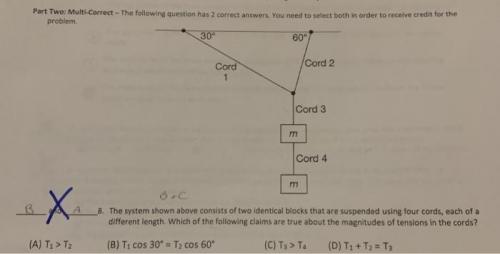 15
15 Explanation:
1. The law that best illustrate this is Newton's first law of motion, which is also called the law of inertia
The law states that every object will continue in the sate of rest or in uniform motion except it is acted upon by an external force. The bike stop moving because it hits a curb.
Inertia: This is the reluctance or the tendency for a body to be in its state of rest or uniform motion.
And Maya is thrown into the air due to it inertia.
2. The Law that best illustrate this is Newton's Third law of motion.
This law states that to every action there is an equal and opposite reaction.
As the bird uses his wind to push air downward, air pushes upward on the bird allows it to fly. the upward and downward movement of air are both equal but opposite reaction.
3. The Law that illustrate this is Newton's second law of motion.
This law can be summarize as force is directly proportional to mass and acceleration.
Because the mass of the second box is smaller than the first box that was why its accelerate at a greater rate.
 15
15 Explanation:
1. The law that best illustrate this is Newton's first law of motion, which is also called the law of inertia
The law states that every object will continue in the sate of rest or in uniform motion except it is acted upon by an external force. The bike stop moving because it hits a curb.
Inertia: This is the reluctance or the tendency for a body to be in its state of rest or uniform motion.
And Maya is thrown into the air due to it inertia.
2. The Law that best illustrate this is Newton's Third law of motion.
This law states that to every action there is an equal and opposite reaction.
As the bird uses his wind to push air downward, air pushes upward on the bird allows it to fly. the upward and downward movement of air are both equal but opposite reaction.
3. The Law that illustrate this is Newton's second law of motion.
This law can be summarize as force is directly proportional to mass and acceleration.
Because the mass of the second box is smaller than the first box that was why its accelerate at a greater rate.


Independent variable: the best method to get rid of them.
Dependent variable: washing with soap and water.
Hypothesis: Organic oils
Control group: water
Answer:
Option DStep-by-step explanation:
D.
Heat each cube to the same temperature, place each cube into different containers with 500 grams of water at the same temperature, and measure the temperature of the water.
Answer:
see below.Step-by-step explanation:
To solve this problem, we can use the conservation of energy and conservation of momentum principles.
Conservation of energy:
The total initial energy is the rest energy of the proton and neutron, which is given by:
Ei = (mp + mn)c^2
where mp and mn are the masses of the proton and neutron, respectively, and c is the speed of light.
The total final energy is the rest energy of the deuteron plus the energy of the gamma ray, which is given by:
Ef = (md)c^2 + Eg
where md is the mass of the deuteron and Eg is the energy of the gamma ray.
According to the conservation of energy principle, the initial energy and final energy must be equal, so we have:
Ei = Ef
(mp + mn)c^2 = (md)c^2 + Eg
Conservation of momentum:
The total initial momentum is zero because the proton and neutron are at rest. The total final momentum is the momentum of the deuteron and the momentum of the gamma ray. Since the gamma ray is massless, its momentum is given by:
pg = Eg/c
where pg is the momentum of the gamma ray.
According to the conservation of momentum principle, the total final momentum must be equal to zero, so we have:
0 = pd + pg
where pd is the momentum of the deuteron.
Solving for md and pd:
From the conservation of energy equation, we can solve for md:
md = (mp + mn - Eg/c^2)/c^2
Substituting this expression into the conservation of momentum equation, we get:
pd = -pg = -Eg/c
Substituting the given values, we have:
mp = 1.6726 × 10^-27 kg mn = 1.6749 × 10^-27 kg Eg = 2.2 × 10^6 eV = 3.52 × 10^-13 J
Using c = 2.998 × 10^8 m/s, we get:
md = (1.6726 × 10^-27 kg + 1.6749 × 10^-27 kg - 3.52 × 10^-13 J/(2.998 × 10^8 m/s)^2)/(2.998 × 10^8 m/s)^2 = 3.3435 × 10^-27 kg
pd = -Eg/c = -(3.52 × 10^-13 J)/(2.998 × 10^8 m/s) = -1.1723 × 10^-21 kg·m/s
Therefore, the mass of the deuteron is 3.3435 × 10^-27 kg, and its momentum is -1.1723 × 10^-21 kg·m/s.
Answer:
9.6 metersStep-by-step explanation:
Time taken by the tomatoes to each the ground
using h = 1/2 g t^2
t^2 = 2h/g = 2 x 50/ 9.8 = 10.2
t = 3.2 sec
horizontal ditance = speed x time = 3 x 3.2 = 9.6 meters
 1
1 The question specifies the diameter of the screw, therefore the IMA of this screw is 0.812? / 0.318 = 8.02

It will provide an instant answer!
